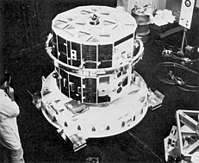Explorer 54
Explorer 54, also called as AE-D (Atmospheric Explorer D), was a NASA scientific satellite belonging to series Atmosphere Explorer, being launched on October 6, 1975 from Vandenberg AFB board a Delta 2910 rocket.
 Explorer 54 (AE-D). | |
| Mission type | Earth science |
|---|---|
| Operator | NASA |
| COSPAR ID | 1975-096A[1] |
| SATCAT no. | 8353[2] |
| Mission duration | 4 months |
| Spacecraft properties | |
| Manufacturer | RCA Astro |
| Launch mass | 681 kg (1,501 lb) |
| Start of mission | |
| Launch date | 6 October 1975, 09:00:50 UTC[3] |
| Rocket | Delta 2910 600/D115 |
| Launch site | Vandenberg SLC-2W[4] |
| End of mission | |
| Decay date | 12 March 1976[2] |
| Orbital parameters | |
| Reference system | Geocentric |
| Regime | Medium Earth |
| Eccentricity | 0.21881[1] |
| Perigee altitude | 154 km (96 mi)[1] |
| Apogee altitude | 3,816 km (2,371 mi)[1] |
| Inclination | 90.1°[1] |
| Period | 126.9 minutes[1] |
| Epoch | 6 October 1975[1] |
Explorers Program | |
Characteristics
The purpose of the Explorer 54 was to continue the investigation begun by Explorer 51 (AE-C) of the chemical processes and energy transfer mechanisms that control the structure and behavior of the earth's atmosphere and ionosphere in the region of high absorption of solar energy. This mission was planned to sample the high latitude regions at the same time that the Explorer 55 (AE-E) mission was sampling the equatorial and low latitude regions. The same type of spacecraft as Explorer 54 was used, and the payload consisted of the same types of instruments except for deletion of the extreme solar UV monitor and the Bennett ion mass spectrometer, which were part of the Explorer 55 payload.
The polar orbit provided the sampling of all latitudes and the perigee moved through all latitudes in 3 months and all local times in 4 months. Unfortunately, a failure in the solar power panels resulted in the termination of operations on 29 January 1976, after slightly less than 4 months of useful life. However, all the regions at the perigee altitudes were sampled during this time. The spacecraft re-entered the atmosphere about 1 month after cessation of telemetry. To continue the correlated observations with the Explorer 55 mission, Explorer 51 was reactivated on 28 February 1976, to replace Explorer 54.[1]
References
- "IMP-H". NSSDC Master Catalog. NASA Goddard Space Flight Center. Retrieved June 21, 2018.

- n2yo.com. "EXPLORER 54 (AE-D)". Retrieved June 21, 2018.
- "Jonathan's Space Page". Jonathan McDowell. Retrieved 2018-06-21.
- Note verbale dated 6 April 1998 from the Permanent Mission of Sweden to the United Nations (Vienna) addressed to the Secretary-General (PDF). COMMITTEE ON THE PEACEFUL USES OF OUTER SPACE. UNOOSA. 1998-04-28. Retrieved 2018-06-20.
.png)